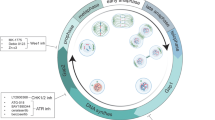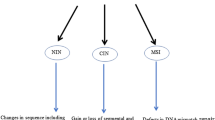Summary
The purpose of this review was to focus mainly on the molecular events related to the progression of cells through the G2 period to examine the cause for G2-arrest in mammalian cells after exposure to various anticancer drugs. With few exceptions, most of the eukaryotic cells exhibit a G2 period in their life cycles. The G2 period, which separates S phase from mitosis, represents the time necessary for the synthesis of the various components related to the condensation of chromosomes, assembly of the mitotic spindle, and cytokinesis. Continued synthesis of RNA and protein is necessary for the successful completion of G2 and the initiation of mitosis. Inhibition of RNA and protein synthesis, replacement of phenylalanine by its analog parafluorophenylalanine, or the elevation of intracellular cAMP concentrations, induce reversible G2 arrest in cultured cells. Exposure of cells to certain antineoplastic drugs also blocks cells preferentially in G2. This irreversible drug-induced G2 arrest is associated with extensive chromosome damage. The G2-arrested cells were found to be deficient in certain proteins that may be specific for the G2-mitotic transition. These mitotic or chromosome condensation factors synthesized during the G2 period, reach their maximum levels at mitosis. A preliminary characterization of the chromosome condensation factor revealed that it is a heat labile, Ca2+-sensitive, nondialyzable protein with a sedimentation value of 4–5S.
Similar content being viewed by others
References
Howard, A. and Pelc, S. R., 1953. Heredity Suppl. 6, 261–273.
Lawrence, P. A., 1968. J. Cell Sci. 3, 391–404.
Liskay, R. M., 1977. Proc. Natl. Acad. Sci. USA 74, 1622–1625.
Taylor, E. W., 1963. J. Cell Biol. 19, 1–18.
Caspersson, T., Farber, S., Foley, G. E., and Killander, D., 1963. Exptl. Cell Res. 32, 529–552.
Arrighi, F. E., and Hsu, T. C., 1965. Exptl. Cell Res. 39,305–308.
Kishimoto, S. and Lieberman, I., 1964. Exptl. Cell Res. 36,92–101.
Tobey, R. A., Petersen, D. F., Anderson, E. C., and Puck, T. T., 1966. Biophys. J. 6, 567–581.
Rao, P. N. and Johnson, R. T., 1970. Nature (London) 225,159–164.
Rao, P. N., Hittelman, W. N., and Wilson, B. A., 1975. Exptl. Cell Res. 90, 40–46.
Rusch, H. P., Sachsenmaier, W., Behrens, K., and Gruter, V., 1966. J. Cell Biol. 31, 204–209.
Gelfant, S., 1963. Symp. Int. Soc. Cell Biol. 2, 229–259.
Vant Hof, J., Hoppin, D. P., and Yagi, S., 1973. Am. J. Bot. 60, 889–895.
Webster, P. L. and Vant Hof, J., 1970. Am. J. Bot. 57, 130–139.
Galfre, G., Howe, S. C., Milstein, C., Butcher, G. W., and Howard, J. C. Nature (London) 266, 550–552.
Williams, A. F., Galfre, G., and Milstein, C., 1977. Cell 12,663–673.
Evans, L. S., Almeida, M. S., Lynn, D. G., and Nakanishi, K., 1979. Science 203, 1122–1123.
Barnstable, C. J., Bodmer, W. F., Brown, G., Galfre, G., Milstein, C., Williams, A. F., and Ziegler, A., 1978. Cell 14, 9–20.
Wheatley, D. N. and Inglis, M. S., 1977. Exptl. Cell Res. 107, 191–199.
Wheatley, D. N. and Henderson, J. Y., 1975. Exptl. Cell Res. 92, 211–220.
Sisken, J. E. and Wilkes, E., 1967. J. Cell Biol. 34, 97–110.
Sheppard, J. R. and Prescott, D. M., 1972. Exptl. Cell Res. 75, 293–296.
Burger, M. M., Bombik, B. M., Breckenridge, B. McL., and Sheppard, J. R., 1972. Nature (London) New Biol. 239,161–163.
Zeilig, C. E., Johnson, R. A., Friedman, D. L., and Sutherland, E. W., 1972. J. Cell Biol. 55, 296a.
Willingham, M. C., Johnson, G. S., and Pastan, I., 1972. Biochem. Biophys. Res. Comm. 48, 743–748.
Nose, K. and Katsuta, H., 1975. Biochem. Biophys. Res. Comm. 64, 983–988.
Sunkara, P. S., Rao, P. N., Thompson, W. J., and Strada, S. J., 1979. J. Cell Biol. (in press).
Barlogie, B., Drewinko, B., Johnston, D. A., and Freireich, E. J., 1976. Cancer Res. 36, 1975–1979.
Krishan, A. and Frei, III, E., 1976. Cancer Res. 36, 143–150.
Gohde, W., Schuman, N. J., Buchner, T., and Barlogie, B., 1974. in Ergebnisse der Adriamycin-Therapie Adriamycin Symposium (Ghione, M., Fetzer, J., and Maier, H., eds.) pp 14–23, Springer-Verlag, Frankfurt/Main.
Ohtsuki, K. and Ishida, N., 1975. J. Antibiot. (Tokyo) 28,143–148.
Ebina, T., Ohtsuki, K., Seto, M., and Ishida, N., 1975. Europ. J. Cancer 11, 155–158.
Barlogie, B., Drewinko, B., Gohde, W., and Bodey, G. P., 1977. Cancer Res. 37, 2583–2588.
Misra, N. C. and Roberts, D., 1975. Cancer Res. 35, 99–105.
Krishan, A., Paika, K., and Frei, III, E., 1975. J. Cell Biol. 66, 521–530.
Puck, T. T. and Steffan, J., 1963. Biophys. J. 3, 379–397.
Bedford, J. S. and Mitchell, J. B., 1977. Radiat. Res. 70,641.
Tobey, R. A. and Crissman, H. A., 1975. Cancer Res. 35,460–470.
Rao, A. P. and Rao, P. N., 1976. J. Natl. Cancer Inst. 57,1139–1143.
Rao, P. N., Wilson, B. A., and Puck, T. T., 1977. J. Cell Physiol. 91, 131–141.
Al-Bader, A. A., Orengo, A., and Rao, P. N., 1978. Proc. Natl. Acad. Sci. USA 75, 6064–6068.
Mahagaokar, S., Rao, P. N., and Barlogie, B., 1976. J. Natl. Cancer Inst. 57, 1305–1310.
Wheeler, G. P., Bono, V. H., Bowdon, B. J., Adamson, D. J., and Brockman, R. W., 1976. Cancer Treat. Rep. 60,1307–1316.
Brockman, R. W., Shaddix, S. C., Williams, M. and Struck R. F. 1976. Cancer Treat. Rep. 60, 1317–1324.
Rao, P. N. and Engelberg, J., 1966. in Cell Synchrony: Studies in Biosynthetic Regulation (Cameron, I. L. and Padilla, G. M. eds.) pp. 332–352, Academic Press, New York.
Sunkara, P. S., Wright, D. A., and Rao, P. N., 1979. Proc. Nat]. Acad. Sci. USA 76, 2799–2802.
Sunkara, P. S., Wright, D. A., and Rao, P. N., 1979. J. Supramol. Struct. (in press).
Author information
Authors and Affiliations
Rights and permissions
About this article
Cite this article
Rao, P.N. The molecular basis of drug-induced G2 arrest in mammalian cells. Mol Cell Biochem 29, 47–57 (1980). https://doi.org/10.1007/BF00230954
Received:
Issue Date:
DOI: https://doi.org/10.1007/BF00230954




